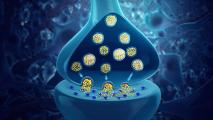A team at MIT has translated a key part of the coronavirus’ structure into music — and their composition could help scientists find a way to stop the virus.
One of the earliest milestones in combating the novel coronavirus SARS-Cov-2 was the detailed mapping of its spike protein, the part of the coronavirus’ structure that allows it to infect human cells.
Through music, we can see the SARS-CoV-2 spike from a new angle.
Markus Buehler
Armed with an atomic-scale map of this protein, researchers began looking for any “druggable sites,” places where drugs or antibodies might be able to bind to the protein and hinder the coronavirus’ ability to infect people.
Now that the MIT team has translated the protein into music, researchers have the ability to begin listening for ways to fight the COVID-19 outbreak, too.
Hearing the Coronavirus’ Structure
Proteins are made up of a chain of chemicals called amino acids that fold into different shapes. The coronavirus’ spike protein consists of an arrangement of three of these chains.
To sonify this key coronavirus’ structure — that is, translate it into sound — the MIT team started by assigning each amino acid a specific musical note. The order of the amino acids in each chain determines the order in which the notes are played in the song.
The team used other musical variables (note duration, volume, etc.) to represent other characteristics of the protein, including its molecular vibrations and places where it folds or stretches.
“We represented the physical protein structure, with its entangled chains, as interwoven melodies that form a multi-layered composition,” Markus Buehler, the professor leading the research, told MIT News.
“The spike protein’s amino acid sequence, its secondary structure patterns, and its intricate three-dimensional folds are all featured,” he added.
Listening to a Spike Protein
Now that the MIT team has sonified this key part of the coronavirus’ structure, the next step is seeing how the song can help us fight the virus.
“When we convert complex data into sound and listen to it, quite often what emerges is something we can understand through sound, even though we could never understand it visually,” Bruce Walker, a psychology professor who runs Georgia Tech Sonification Lab, told Freethink in 2019.
Walker is speaking from experience.
After he converted different physical aspects of moles (color, texture, etc.) into sounds, doctors listening to the compositions were able to detect cancer with 90% accuracy — a vast improvement on the 40% accuracy of visual assessment alone.
This ability to quickly “hear” more information can be particularly useful when studying proteins, according to Buehler.
“Our brains are great at processing sound! In one sweep, our ears pick up all of its hierarchical features: pitch, timbre, volume, melody, rhythm, and chords,” he said. “We would need a high-powered microscope to see the equivalent detail in an image, and we could never see it all at once.”
The spike protein’s song may improve scientists’ understanding of the protein, drawing their attention to aspects of it they could have overlooked in visual representations.
For example, researchers might compare the song to the musical representations of other proteins, such as the closely related coronavirus’ SARS and MERS, to gain a new understanding of the virus.
The song might even help scientists identify druggable sites within the coronavirus’ structure if they search it for musical sequences that correspond to the desirable sites. Or help them identify proteins that could be effective antibodies due to the fact that they have similar melodies.
As Bueher summed it up for MIT News, “Through music, we can see the SARS-CoV-2 spike from a new angle.”





